Amana ACE184XR, ACE184XS, ACE244XR, ACE244XS, ACQ304XS Owner's Manual
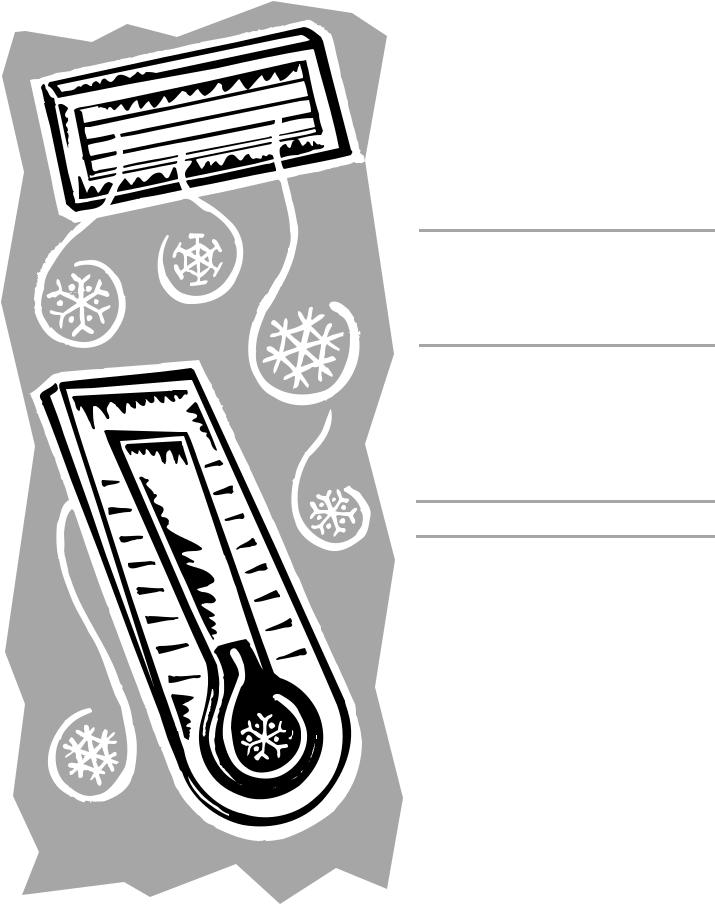
AIR CONDITIONER
Use & Care Guide
For questions about features, operation/performance, parts, accessories or service, call: 1-800-253-1301 in the U.S.A.
ACONDICIONADOR
DE AIRE
Manual de Uso y Cuidado
Si tiene preguntas respecto a las características, funcionamiento, rendimiento, partes, accesorios o servicio técnico,
llame al: 1-800-253-1301 en los EE. UU.
Table of Contents/Índice ..................................... |
2 |
1188127A
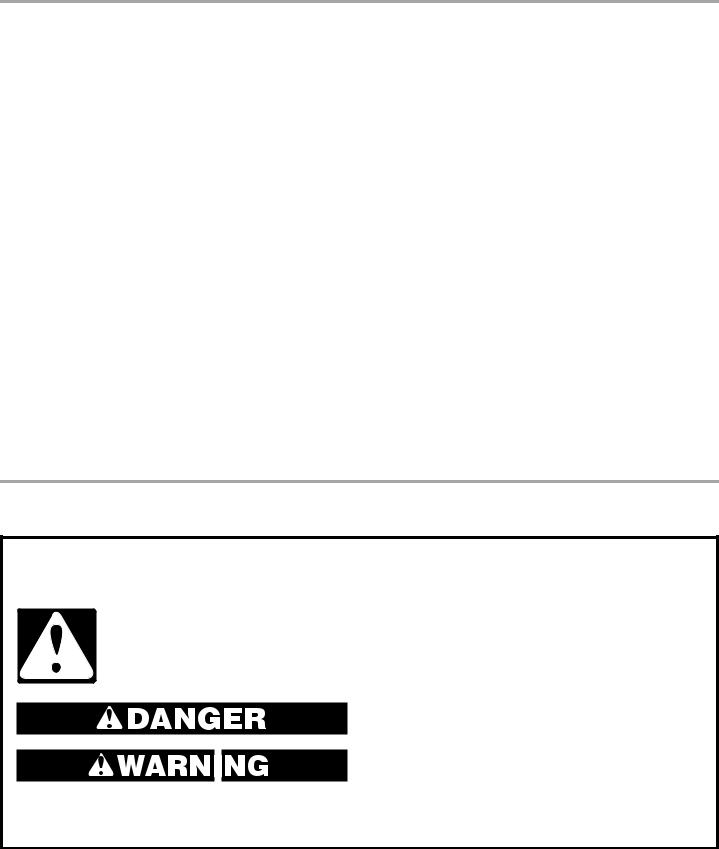
TABLE OF CONTENTS
AIR CONDITIONER SAFETY ......................................................... |
2 |
Starting Your Air Conditioner—Rotary Controls |
........................14 |
||
INSTALLATION REQUIREMENTS ................................................ |
3 |
Changing Air Direction ............................................................... |
16 |
||
|
Tools and Parts ............................................................................ |
3 |
Normal Sounds........................................................................... |
16 |
|
|
Location Requirements................................................................ |
3 |
AIR CONDITIONER CARE ........................................................... |
16 |
|
|
Electrical Requirements ............................................................... |
4 |
Cleaning the Air Filter ................................................................. |
16 |
|
INSTALLATION INSTRUCTIONS .................................................. |
5 |
Cleaning the Front Panel............................................................ |
16 |
||
|
Unpacking .................................................................................... |
5 |
Repairing Paint Damage ............................................................ |
16 |
|
|
Installing the Cabinet in a Window .............................................. |
6 |
Annual Maintenance................................................................... |
16 |
|
|
Installing the Cabinet Through a Wall .......................................... |
9 |
TROUBLESHOOTING .................................................................. |
17 |
|
|
Complete Installation ................................................................. |
10 |
ASSISTANCE OR SERVICE |
18 |
|
AIR CONDITIONER USE |
11 |
||||
Accessories ................................................................................ |
18 |
||||
|
Starting Your Air Conditioner—Digital Control .......................... |
11 |
|
|
|
|
|
|
|
|
|
ÍNDICE
SEGURIDAD DEL ACONDICIONADOR DE AIRE...................... |
19 |
REQUISITOS DE INSTALACIÓN................................................. |
19 |
Herramientas y piezas................................................................ |
19 |
Requisitos de ubicación............................................................. |
20 |
Requisitos eléctricos.................................................................. |
21 |
INSTRUCCIONES DE INSTALACIÓN......................................... |
22 |
Desempaque .............................................................................. |
22 |
Instalación del gabinete en una ventana ................................... |
23 |
Instalación del gabinete a través de la pared............................ |
25 |
Para completar la instalación..................................................... |
27 |
USO DE SU ACONDICIONADOR DE AIRE................................ |
28 |
Cómo poner en marcha su acondicionador de aire — |
|
Control digital ............................................................................. |
29 |
Cómo poner en marcha su acondicionador de aire — |
|
Controles rotativos ..................................................................... |
32 |
Cómo cambiar la dirección del aire ........................................... |
33 |
Sonidos normales....................................................................... |
33 |
CUIDADO DE SU ACONDICIONADOR DE AIRE....................... |
34 |
Limpieza del filtro de aire ........................................................... |
34 |
Limpieza del panel delantero ..................................................... |
34 |
Reparación de la pintura dañada............................................... |
34 |
Mantenimiento anual.................................................................. |
34 |
SOLUCIÓN DE PROBLEMAS...................................................... |
34 |
AYUDA O SERVICIO TÉCNICO................................................... |
36 |
Accesorios.................................................................................. |
36 |
AIR CONDITIONER SAFETY
Your safety and the safety of others are very important.
We have provided many important safety messages in this manual and on your appliance. Always read and obey all safety messages.
This is the safety alert symbol.
This symbol alerts you to potential hazards that can kill or hurt you and others.
All safety messages will follow the safety alert symbol and either the word “DANGER” or “WARNING.” These words mean:
You can be killed or seriously injured if you don't immediately follow instructions.
You can be killed or seriously injured if you don't follow instructions.
All safety messages will tell you what the potential hazard is, tell you how to reduce the chance of injury, and tell you what can happen if the instructions are not followed.
2
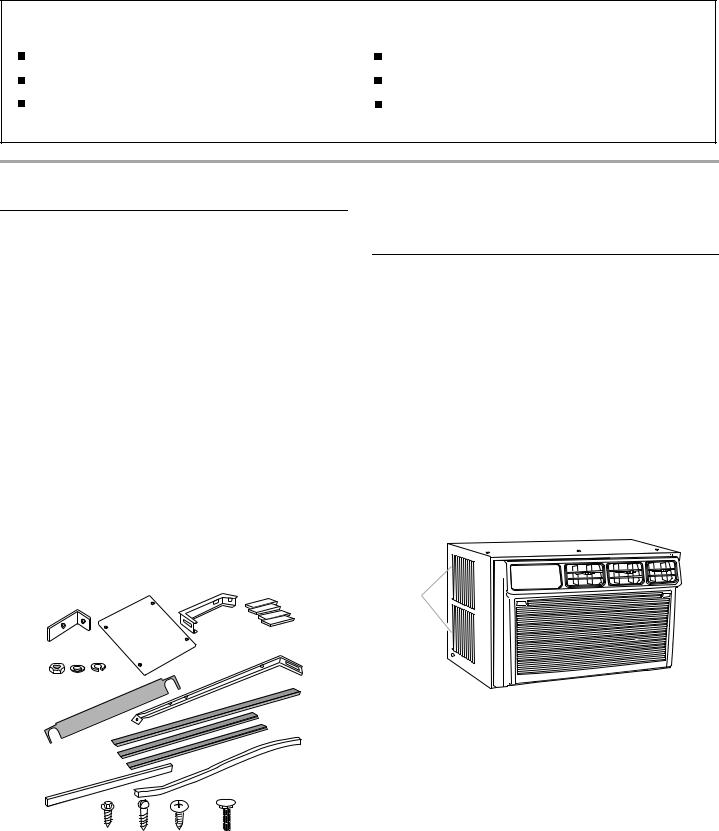
IMPORTANT SAFETY INSTRUCTIONS
WARNING: To reduce the risk of fire, electrical shock or injury when using your air conditioner, follow these basic precautions:
Do not use an extension cord.
Unplug air conditioner before servicing.
Use two or more people to move and install air conditioner.
SAVE THESE INSTRUCTIONS
INSTALLATION REQUIREMENTS
Tools and Parts
Gather the required tools and parts before starting installation. Read and follow the instructions provided with any tools listed here.
Tools Needed
■ |
Flat-blade and Phillips |
■ |
Scissors |
|
|
screwdrivers |
■ |
Tape measure |
|
|
Level |
|||
■ |
■ |
Drill and ³⁄" or smaller bit |
||
■ Socket wrench and ⁄" |
||||
■ |
¹⁄" nut driver |
|||
|
and ¹⁄" sockets |
|||
|
|
Utility knife |
||
■ |
Pencil |
■ |
||
|
|
|||
Through-the-wall installation:
In addition to the tools listed above, the following tools are needed for though-the-wall installation.
■ |
Saw |
■ |
1" (2.5 cm) or thicker |
■ |
Wood preservative |
|
lumber |
|
7 - #10 x 1" wood screws |
||
■ |
Caulk |
■ |
|
|
|
Parts supplied (on some models)
Check that all parts are included in parts package.
A B C D
E F G
|
|
H |
|
|
I |
|
J |
|
|
|
|
|
|
|
|
|
K |
|
|
L |
|
|
|
|
M |
N |
O |
P |
|
A. Window-lock |
G. Lock washers (6) |
|
M. #8 x ¹⁄ " hex-head |
|
bracket |
H. Angle supports (2) |
|
metal screws (4) |
|
B. Filler board |
I. 2¹⁄ " (6.4 cm) seal strip |
N. #10 x ³⁄ " round-head |
||
C. Vertical supports (2) |
J. Foam seals for air |
|
wood screws (3) |
|
D. Foam blocks (4) |
conditioner (3) |
|
O. #8 - 18 x ³⁄ " round- |
|
E. Nuts (6) |
K. Foam window sash |
|
head screws (2) |
|
|
P. ³⁄ " round-head |
|||
F. Flat washers (6) |
seal |
|
|
|
|
L. Window rail seal |
|
bolts (6) |
|
|
|
|
||
NOTE: Installation parts are supplied for double-hung windows up to 40" (101.6 cm) wide. A special Wide Window Kit is available from your dealer or service center. See “Accessories.”
Location Requirements
IMPORTANT: Observe all governing codes and ordinances.
Check the location where air conditioner will be installed. Proper installation is your responsibility. Make sure you have everything necessary for correct installation.
The location should provide:
■Grounded electrical outlet within 4 ft (122 cm) of where the power cord exits the air conditioner.
NOTE: Do not use an extension cord.
■Free movement of air in room to be cooled.
■A large enough opening for the air conditioner.
■Adequate wall support for weight of air conditioner. Air conditioner weighs between 145 and 200 lbs (65 to 96 kg).
NOTES: Cabinet louvers must not be obstructed. Air must be able to pass freely through the cabinet louvers.
A 
A. Cabinet louvers
3
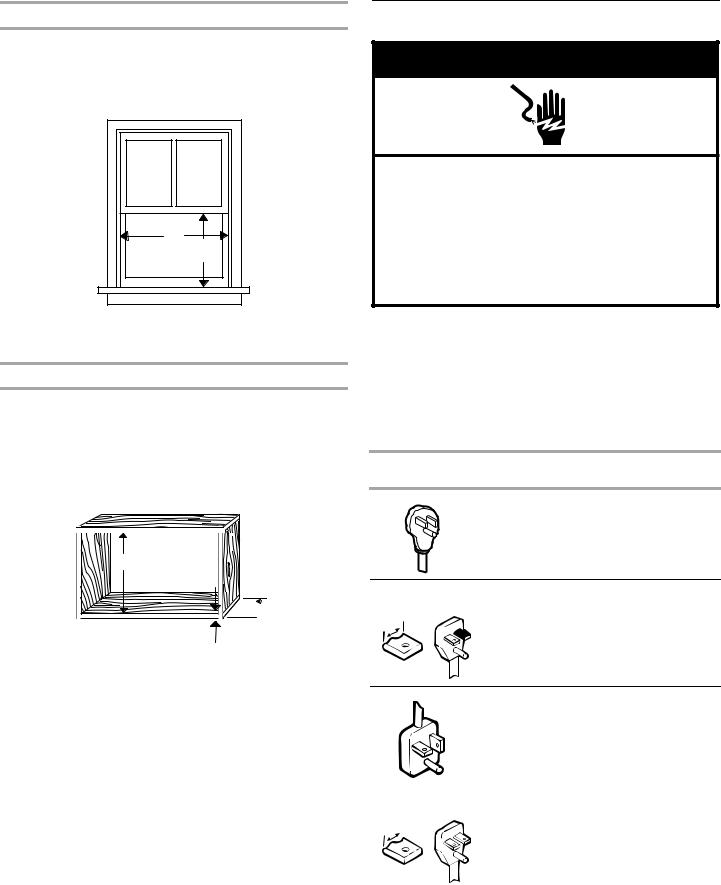
Window installation
Window opening measurements:
■26¹⁄ " (66.1 cm) minimum to 40" (101.6 cm) maximum opening width.
■20" (50.8 cm) minimum opening height.
A |
B |
A. 26¹⁄ " (66.1 cm) minimum |
B. 20" (50.8 cm) minimum
Through-the-wall installation
The wall opening measurements should be:
■Width: 26¹⁄ " (66.1 cm) plus twice thickness of wood used to build frame.
■Height: 19³⁄ " (50.2 cm) plus twice thickness of wood used to build frame.
■Depth: 2¹⁄ " (6.4 cm) minimum to 8" (20.3 cm) maximum.

 C
C
A
 B
B 
 D
D
|
C |
A. 19³⁄ " (50.2 cm) |
C. Wood thickness |
B. 26¹⁄ " (66.1 cm) |
D. 2¹⁄ " (6.4 cm) minimum to |
|
8" (20.3 cm) maximum |
Electrical Requirements
 WARNING
WARNING
Electrical Shock Hazard
Plug into a grounded 3 prong outlet.
Do not remove ground prong.
Do not use an adapter.
Do not use an extension cord.
Failure to follow these instructions can result in death, fire, or electrical shock.
Ground wire must be connected to ground screw located in lower right corner of air conditioner when air conditioner is in cabinet.
The electrical ratings for your air conditioner are listed on the model and serial number label. The model and serial number label is located behind the front panel on the flange below the control panel area.
Specific electrical requirements are listed in the chart below. Follow the requirements for the type of plug on the power supply cord.
Power supply |
|
cord |
Wiring requirements |
■115-volt (103.5 min. - 126.5 max.)
|
■ |
0-12 amps |
|
■ 15-amp time-delay fuse or circuit breaker |
|
|
■ Use on single outlet circuit only. |
|
¹⁄ " |
■ 230-volt (207 min. - 253 max.) |
|
|
0-12 amps |
|
(0.6 cm) |
■ |
|

 ■ 15-amp time-delay fuse or circuit breaker
■ 15-amp time-delay fuse or circuit breaker
■ Use on single outlet circuit only.
■230-volt (207 min. - 253 max.)
■0-16 amps
|
|
|
■ 20-amp time-delay fuse or circuit breaker |
|
|
|
■ Use on single outlet circuit only. |
|
|
|
|
|
¹⁄ " |
■ 230-volt (207 min. - 253 max.) |
|
|
■ 0-24 amps |
||
(1.3 cm) |
|||
|
|
|
■ 30-amp time-delay fuse or circuit breaker |
|
|
|
|
|
|
|
|
|
|
|
■ Use on single outlet circuit only. |
|
|
|
|
4
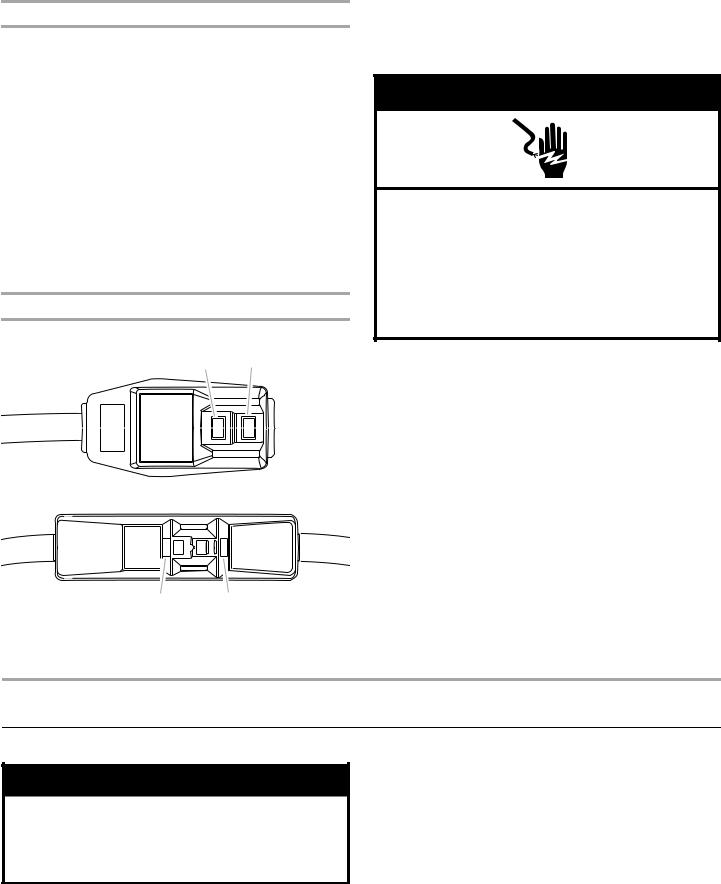
Recommended ground method
This air conditioner must be grounded. This air conditioner is equipped with a power supply cord having a grounded 3 prong plug. To minimize possible shock hazard, the cord must be plugged into a mating, grounded 3 prong outlet, grounded in accordance with all local codes and ordinances. If a mating outlet is not available, it is the customer's responsibility to have a properly grounded 3 prong outlet installed by a qualified electrical installer.
It is the customer's responsibility:
■To contact a qualified electrical installer.
■To assure that the electrical installation is adequate and in conformance with National Electrical Code, ANSI/NFPA 70 - latest edition, and all local codes and ordinances.
Copies of the standards listed may be obtained from:
National Fire Protection Association
One Batterymarch Park
Quincy, MA 02269
Power Supply Cord
NOTE: Your unit’s device may differ from the ones shown.
B A
| <![if ! IE]> <![endif]>TEST |
<![if ! IE]> <![endif]>RESET |
| <![if ! IE]> <![endif]>TEST |
<![if ! IE]> <![endif]>RESET |
BA
A.Reset button
B.Test button
This room air conditioner is equipped with a power supply cord required by UL. This power supply cord contains state-of-the-art electronics that sense leakage current. If the cord is crushed, the electronics detect leakage current and power will be disconnected in a fraction of a second.
 WARNING
WARNING
Electrical Shock Hazard
Plug into a grounded 3 prong outlet.
Do not remove ground prong.
Do not use an adapter.
Do not use an extension cord.
Failure to follow these instructions can result in death, fire, or electrical shock.
To test your power supply cord:
1.Plug power supply cord into a grounded 3 prong outlet.
2.Press RESET.
3.Press TEST (listen for click; Reset button will trip and pop out).
4.Press and release RESET (listen for click; Reset button will latch and remain in). The power supply cord is ready for operation.
NOTES:
■The Reset button must be pushed in for proper operation.
■The power supply cord must be replaced if it fails to trip when the test button is pressed or fails to reset.
■Do not use the power supply cord as an off/on switch. The power supply cord is designed as a protective device.
■A damaged power supply cord must be replaced with a new power supply cord obtained from the product manufacturer and must not be repaired.
■The power supply cord contains no user serviceable parts. Opening the tamper-resistant case voids all warranty and performance claims.
INSTALLATION INSTRUCTIONS
Unpacking
 WARNING
WARNING
Excessive Weight Hazard
Use two or more people to move and install air conditioner.
Failure to do so can result in back or other injury.
Remove packaging materials
■Remove and properly dispose of packaging materials. Remove tape and glue residue from surfaces before turning on the air conditioner. Rub a small amount of liquid dish soap over the adhesive with your fingers. Wipe with warm water and dry.
■Do not use sharp instruments, rubbing alcohol, flammable fluids, or abrasive cleaners to remove tape or glue. These products can damage the surface of your air conditioner.
■Handle air conditioner gently.
5
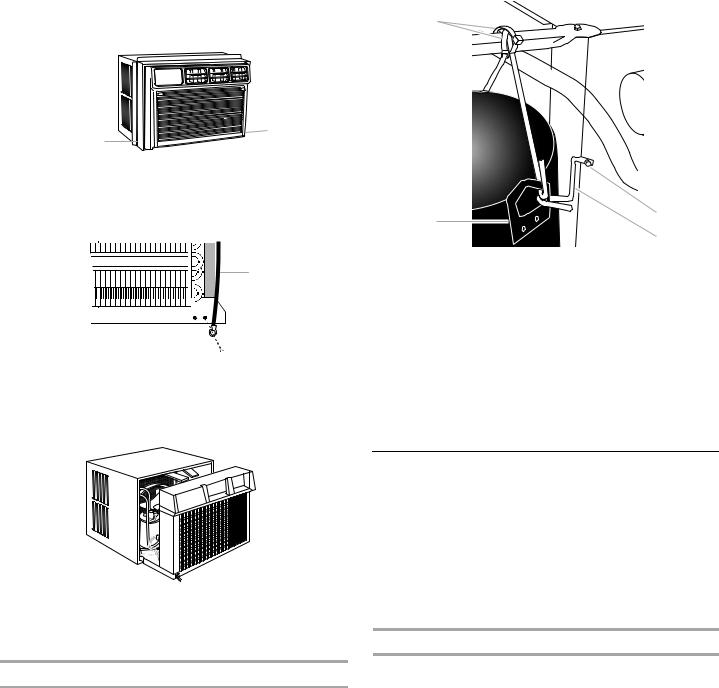
1.Remove air conditioner from carton and place it on cardboard.
2.Remove shipping screws from each side wall of cabinet.
A
A 
A.Shipping screws
3.Remove front panel from air conditioner and set aside.
4.Remove ground screw and ground wire from front of air conditioner base. Save ground screw.
A

 B
B
A.Green ground wire
B.Ground screw
5.Pull on handle to slide air conditioner out of cabinet. Place air conditioner on cardboard.
 A
A
A. Handle
NOTE: Do not lift, push, pull or remove any expanded polystyrene (foam) from inside the air conditioner. It is not packing material.
Shipping bracket removal (on some models)
1.To remove upper shipping bracket from unit support bracket, cut the 2 wire ties with scissors.
2.Lift the end of the upper shipping bracket off of the unit support bracket and remove the other end from compressor flange.
A
B 
C 
D |
E |
|
|
|
F |
A. Wire ties (2) |
D. Compressor flange |
B. Unit support bracket |
E. Remove this screw |
C. Upper shipping bracket |
F. Lower shipping bracket |
3.Remove screw from end of lower shipping bracket attached to divider wall using a ¹⁄" nut driver or socket wrench.
4.Remove the other end of lower shipping bracket from compressor flange.
NOTES:
■If compressor flange interferes with sliding air conditioner back into cabinet, bend flange back against the compressor.
■Reinstall shipping brackets only if unit will be moved from its present location.
Installing the Cabinet in a Window
■Handle air conditioner gently.
■Be sure your air conditioner cabinet does not fall out of the opening during installation or removal.
■The place where the power cord exits the air conditioner should be no more than 4 ft (122 cm) from a grounded 3 prong outlet.
■Do not block the louvers on the front panel.
■Do not block the louvers on the outside of the air conditioner.
Filler board installation
1.Center empty cabinet in window. Maintain a firm hold on the air conditioner cabinet. Lower window sash to hold cabinet in place.
2.Measure the distance between the right side of the cabinet and the inside of the window channel.
3.Repeat for the left side.
6
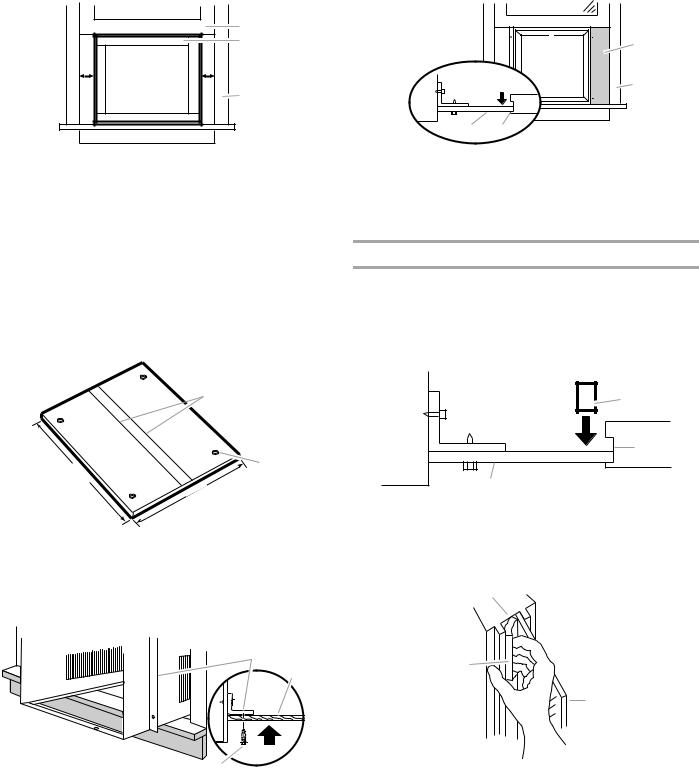
4.Adjust the cabinet until the distance on each side is the same. Then add ¹⁄ " (3.2 mm) for the final measurement to be used in the next step.
9.Place cabinet back into the window with right filler board tight against window channel. Insert left filler board into window channel.
A |
B |
C |
A.Window sash
B.Empty cabinet
C.Window channel
5.Use final measurement to measure in from each edge of the filler board. Mark lines in such a way that the outside edges of the filler board will contain the screw holes.
6.Place cardboard or other protective material on a sturdy, flat surface. Position filler board on top of the protective material to keep from cutting into the surface below.
7.Place a ruler or straight edge along the lines drawn previously and use a utility knife to cut filler boards to size along the lines. Make cut so the outside edges of filler boards will have screw holes.
A
B
C
|
D |
A. Lines |
C. Long edge |
B. Screw hole |
D. Short edge |
8.Pull cabinet part way out of window. Attach right filler board to front of a side-mounting angle with two ¹⁄ " hex-head screws.
B
A
C
Top View
A.Right filler board
B.Side-mounting angle
C.¹⁄" hex-head screw
A
Top View
B
AB
A.Right filler board
B.Window channel
10.Push left filler board against side-mounting angle and attach with two ¹⁄ " hex-head screws. From the outside, push filler boards as far forward in window channels as possible.
Foam block installation
1.Measure the distance between the channel edge and the filler board.
2.Cut foam blocks ¹⁄ " (6.4 mm) wider and insert into channel behind filler boards.
Top View
C
B
A
A.Filler board
B.Window channel
C.Foam block
Outside View
A
C
B
A.Window channel
B.Filler board
C.Foam block
7
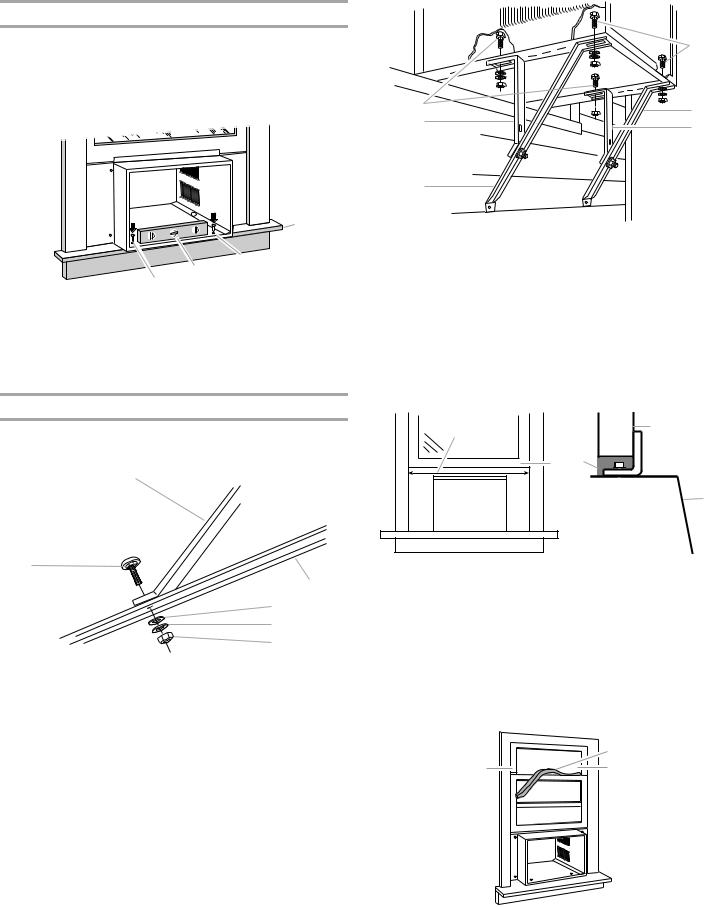
Level cabinet
1.Use a level to check that cabinet is level side to side.
2.Use a ³⁄" drill bit to drill 2 starter holes through the 2 holes in the cabinet and into the windowsill.
3.Attach cabinet to window with 2 - #10 - 12 x ³⁄" wood screws.
 C
C
B
A
B
A.Level
B.Wood screw
C.Windowsill
4.Check that air conditioner cabinet is tilted to the outside so that water will run to the outside.
Secure cabinet to window
1.Attach vertical support to angle support. Do not overtighten nut. Repeat.
E
A
F
B
C
D
A. Bolt |
D. Nut |
B. Flat washer |
E. Vertical support |
C. Lock washer |
F. Angle support |
2.Attach support assembly to bottom of cabinet. Attach vertical supports to cabinet first. Do not tighten nuts at this time.
3.Attach angle supports to cabinet. Do not tighten nuts at this time. Slide each support assembly toward house until they are firmly against wall.
NOTE: If your house is constructed of material that could be damaged by angle supports, fasten a board between angle supports and house.
4.Check that cabinet still tilts to the outside so that water will run to the outside.
5.Tighten nuts securely (do not overtighten) with a ⁄" socket and socket wrench. Tighten angle support nuts last so angle supports fit tightly against house.
8
 A
A
A 

C
B
A.Bolts
B.Angle supports
C.Vertical supports
B |
C |
6.Measure inside width of window frame.
7.Cut foam window sash seal with square ends to fit.
8.Hold cabinet to prevent it from falling. Raise window sash. Align foam seal with front edge of window sash and attach seal with adhesive side against underside of sash. Lower window sash.
Front View |
Side View |
A B
B C
D
 D
D
A. Width of frame |
C. Foam window sash seal |
B. Sash |
D. Cabinet |
9.Insert window rail seal behind the top of the lower window sash and against the glass of the upper window.
10.Place window-lock bracket on top of lower window and against upper window sash.
11.Use a ³⁄" drill bit to drill a starter hole through the hole in the bracket into the window sash.
12.Attach window-lock bracket to window sash with #10 - 12 x ³⁄" wood screw to secure window in place.
B
A  C
C
A.Window lock bracket
B.Window rail seal
C.Upper window glass

Installing the Cabinet Through a Wall
■Handle air conditioner gently.
■Be sure your air conditioner cabinet does not fall out of the opening during installation or removal.
■The place where the power cord exits the air conditioner should be no more than 4 ft (122 cm) from a grounded 3 prong outlet.
■It is the customer's responsibility and obligation to have this product installed by a qualified technician familiar with through-the-wall room air conditioner installations.
■Do not block the louvers on the front panel.
■Do not block the louvers on the outside of the air conditioner.
Option 1—Wood, metal or plastic molding
When using a wood, metal or plastic molding, the wood frame should line up with inside wall as shown.
A B C
D
|
|
|
|
|
|
|
|
|
|
A. Molding |
C. Wood frame |
|||
B. Inside wall |
D. Louvers |
|||
Option 2—Plaster wall with no molding
If the plastered wall is to be flush with the cabinet and no molding is used, the wood frame must be set ¹⁄ " (13 mm) into the inside wall.
A B C
■Use 1" (2.5 cm) or thicker lumber for wood frame.
 A
A
B |
C |
A.Outside width
B.Outside height
C.Depth
4.Apply wood preservative to the outside exposed surface.
5.Insert the frame in the wall opening. Square and level frame.
6.Attach frame securely to the wall.
Installing cabinet into wood frame
1.Remove top channel and both side channels using a ¹⁄ " nut driver or socket wrench. Discard top channel and both side channels.
A
A
A
 D
D
A. Remove these screws
|
|
|
|
|
|
A. Plastered wall |
C. Wood frame |
|
B. Inside wall |
D. Louvers |
|
Installing wood frame
2.Insert cabinet into the framed wall opening. The top of the cabinet should extend ³⁄ " (19.1 mm) into the room. If there is trim, the cabinet should extend ³⁄ " (19.1 mm) past the trim.
B
A
1.Construct wood frame. See “Location Requirements” for dimensions.
2.Measure outside width and height of frame to determine wall opening dimensions.
3.Cut opening through the wall. Remove and save insulation.
NOTES:
■Dimension for depth depends on wall thickness and type of molding.
■Do not block louvers in air conditioner cabinet.
A.³⁄ " (19.1 mm) extending into room
B.Trim
9
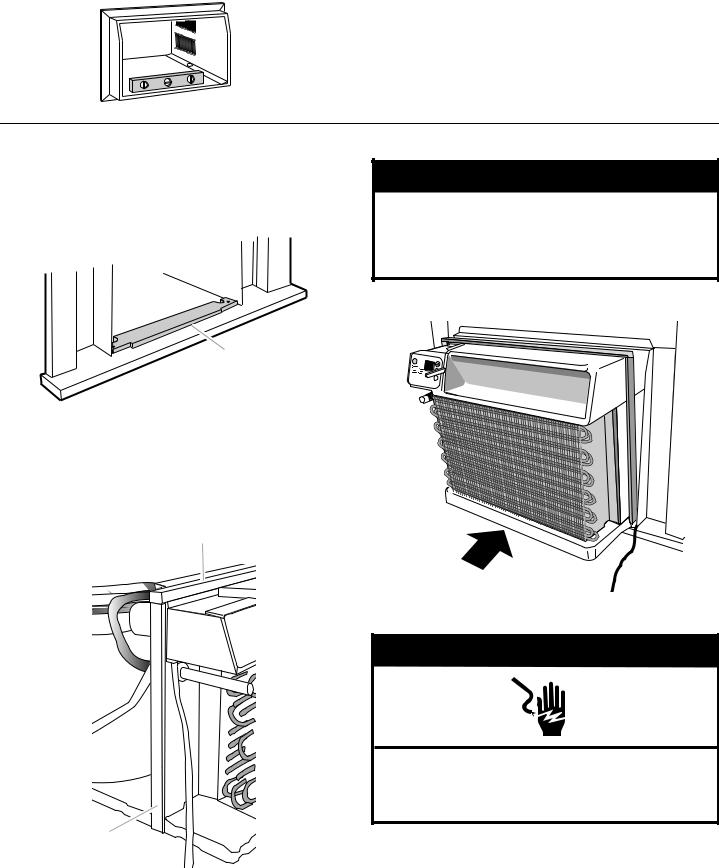
3. Use a level to check that cabinet is level side to side.
 A
A
A. Level
4.Check that air conditioner cabinet is tilted to the outside so that water will run to the outside.
5.Reuse the insulation to seal opening between cabinet and frame.
6.Use existing holes in sides and top of cabinet and 7 - #10 x 1" wood screws (not provided) to attach cabinet to frame.
NOTE: Do not overtighten screws or cabinet will distort and provide a poor air seal between cabinet and air conditioner.
7.Caulk all outside wall openings around cabinet.
Complete Installation
1.Peel paper from adhesive backing on the 2¹⁄ " (6.4 cm) seal strip. Place the 2¹⁄ " (6.4 cm) seal strip inside the cabinet. Make seal flush with cabinet front edge.
NOTE: This seal strip fits between the air conditioner base and the cabinet.
A
 WARNING
WARNING
Excessive Weight Hazard
Use two or more people to move and install air conditioner.
Failure to do so can result in back or other injury.
4. Insert air conditioner into cabinet.
A. 2¹⁄" seal strip
NOTE: Handle air conditioner gently.
2.Peel paper from adhesive backing on one of the 2 short air conditioner seals. Align left-side air conditioner seal against metal flange behind control box. Attach long, top air conditioner seal over seam in top of air condtioner and rightside air conditioner seal so they align with left seal.
A
B
 A
A
A.Make sure the free end of the ground wire is outside of the cabinet.
 WARNING
WARNING
Electrical Shock Hazard
Connect green ground wire to ground screw.
Failure to do so can result in death or electrical shock.
5.Connect green ground wire to cabinet base with ground screw.
A.Long, top air conditioner seal
B.Short left-side air conditioner seal
3.Make sure the free end of the ground wire is outside of the cabinet.
10

Position ground wire pointing straight up. Put excess ground wire between coil and air conditioner cabinet.
A

 B
B
A.Green ground wire
B.Ground screw
6.Push front panel straight on and then lower it slightly to lock it into place.
7.Using the indents in top of filter door, pull door down.
A
A.Indents
8.Using 2 - #8 - 18 x ³⁄" round-head screws, attach bottom front of panel.
A
B
A.Front of unit
B.2 - #8 - 18 x ³⁄" round-head screws
NOTE: For through-the-wall installations, if needed, install molding around room side of cabinet.
 WARNING
WARNING
Electrical Shock Hazard
Plug into a grounded 3 prong outlet.
Do not remove ground prong.
Do not use an adapter.
Do not use an extension cord.
Failure to follow these instructions can result in death, fire, or electrical shock.
9.Plug into a grounded 3 prong outlet.
10.Press RESET on the power supply cord.
AIR CONDITIONER USE
Operating your air conditioner properly helps you to obtain the best possible results.
This section explains proper air conditioner operation.
IMPORTANT:
■If you turn the air conditioner off, wait at least 3 minutes before turning it back on. This prevents the air conditioner from blowing a fuse or tripping a circuit breaker.
■Do not try to operate your air conditioner in the cooling mode when outside temperature is below 65°F (18°C). The inside evaporator coil will freeze up, and the air conditioner will not operate properly.
NOTE: In the event of a power failure, your air conditioner will operate at the previous settings when the power is restored.
Starting Your Air Conditioner—
Digital Control
11
